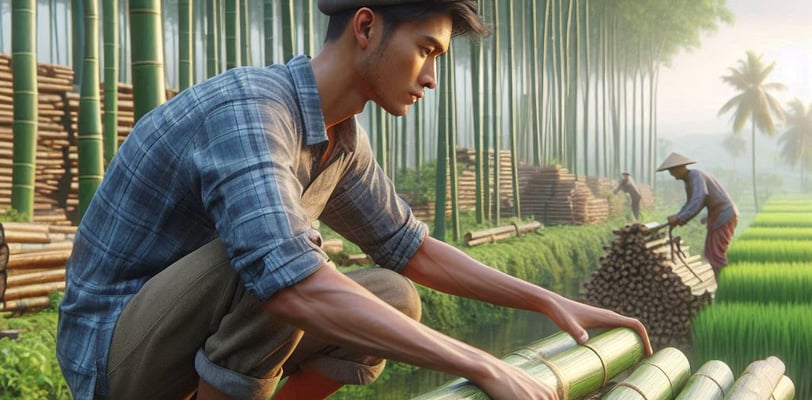The History and Significance of Bamboo Handicrafts
Bamboo, often referred to as the “green gold,” has been an integral part of human civilization for centuries. Its use in handicrafts not only showcases the ingenuity and artistry of various cultures but also underscores its ecological importance


Bamboo, often referred to as the “green gold,” has been an integral part of human civilization for centuries. Its use in handicrafts not only showcases the ingenuity and artistry of various cultures but also underscores its ecological importance. Here’s a dive into the history and significance of bamboo handicrafts.
Historical Background
1. Ancient Origins Bamboo has been used in handicrafts for thousands of years, with its origins tracing back to ancient civilizations in Asia. In China, bamboo was used as early as 5000 BCE for making everyday items such as baskets, mats, and tools. The Chinese also documented its significance in literature and art, highlighting its versatility and cultural importance.
2. Spread Across Cultures As trade routes expanded, bamboo handicrafts spread to other parts of Asia, including Japan, India, and Southeast Asia. Each culture adapted bamboo to suit their needs, leading to a variety of unique crafting techniques. In Japan, bamboo was used to create intricate tea ceremony utensils, while in India, it became an essential material for building and crafting musical instruments.
3. Modern-Day Usage In contemporary times, bamboo handicrafts have gained global popularity. Artisans from different cultures continue to innovate, combining traditional methods with modern designs to create functional and decorative items. The eco-friendly nature of bamboo has further propelled its demand, making it a preferred material for sustainable living.
4. Cultural Significance
Symbolism in Art and Culture Bamboo is often revered in various cultures for its strength, flexibility, and resilience. In Chinese culture, it symbolizes longevity, virtue, and grace. These attributes are frequently depicted in Chinese paintings, poetry, and proverbs. Similarly, in Japanese culture, bamboo represents purity and innocence, often featured in traditional gardens and art.
Craftsmanship and Tradition The crafting of bamboo items is a skill passed down through generations, preserving traditional knowledge and techniques. For example, the intricate weaving methods used in bamboo basketry reflect the meticulous craftsmanship of artisans. These handcrafted items are not only practical but also carry cultural heritage and stories.
Sustainable Practices Bamboo’s rapid growth and renewability make it an environmentally friendly material. Communities that rely on bamboo handicrafts often practice sustainable harvesting, ensuring the preservation of bamboo forests. This sustainable approach not only supports local economies but also promotes ecological balance.
5. Modern Significance
Eco-Friendly Alternative With the growing awareness of environmental issues, bamboo handicrafts have emerged as a sustainable alternative to plastic and other non-renewable materials. Bamboo’s biodegradability and minimal environmental impact make it a preferred choice for eco-conscious consumers. Items such as bamboo straws, cutlery, and home decor help reduce plastic waste and promote a greener lifestyle.
Versatility and Innovation Modern artisans continue to explore the versatility of bamboo, creating innovative designs that cater to contemporary tastes. From sleek furniture and stylish accessories to intricate artworks, bamboo handicrafts combine traditional techniques with modern aesthetics. This fusion of old and new appeals to a broad audience, ensuring the continued relevance of bamboo in today’s market.
Economic Empowerment Bamboo handicrafts provide economic opportunities for artisans, particularly in rural communities. The demand for handmade, sustainable products has opened up new markets, allowing artisans to showcase their skills globally. This economic empowerment supports sustainable livelihoods and contributes to the preservation of traditional craftsmanship.
Conclusion
The history and significance of bamboo handicrafts highlight the remarkable journey of this versatile material from ancient times to the modern era. Its cultural symbolism, ecological benefits, and the craftsmanship it embodies make bamboo a truly unique and valuable resource. Embracing bamboo handicrafts not only adds beauty and functionality to our lives but also supports sustainable practices and honors age-old traditions. As we move towards a more sustainable future, bamboo handicrafts will undoubtedly continue to play a vital role.
